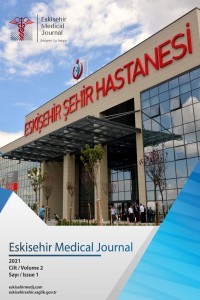KORONER YAVAŞ AKIM FENOMENİ İLE ENDOTEL NİTRİK OKSİT SENTAZ'IN GLU298ASP VE T786-C GEN POLİMORFİZMLERI ARASINDAKİ İLİŞKİ
Koroner yavaş akım, endoteliyal nitrik oksit sentaz, Genetik polimorfizim
THE RELATIONSHIP BETWEEN GLU298ASP AND T786-C GENE POLYMORPHISMS OF ENDOTHELIAL NITRIC OXIDE SYNTHASE AND CORONARY SLOW-FLOW PHENOMENON
___
- 1. Tambe A, Demany M, Zimmerman HA, Mascarenhas E. Angina pectoris and slow flow velocity of dye in coronary arteries-a new angiographic finding. Am Heart J. 1972;84:66-71.
- 2. Goel PK, Gupta SK, Agarwal A, Kapoor A. Slow coronary flow: a distinct angiographic subgroup in syndrome X. Angiology. 2001;52:507-14.
- 3. Mangieri E, Macchiarelli G, Ciavolella M, et al. Slow coronary flow: clinical and histopathological features in patients with otherwise normal epicardial coronary arteries. Cathet Cardiovasc Diagn. 1996;37:375-81.
- 4. Burckhartt BA, Mukerji V, Alpert MA. Coronary artery slow flow associated with angina pectoris and hypotension: a case report. Angiology. 1998;49:483-7.
- 5. Gökçe M, Kaplan S, Tekelioǧlu Y, Erdoǧan T, Küçükosmanoǧlu M. Platelet function disorder in patients with coronary slow flow. Clin Cardiol. 2005;28:145-8.
- 6. Lanza G, Andreotti F, Sestito A, Sciahbasi A, Crea F, Maseri A. Platelet aggregability in cardiac syndrome X. Eur Heart J. 2001;22:1924-30.
- 7. Rim S-J, Leong-Poi H, Lindner JR, Wei K, Fisher NG, Kaul S. Decrease in coronary blood flow reserve during hyperlipidemia is secondary to an increase in blood viscosity. Circulation. 2001;104:2704-9.
- 8. Forssmann W. Die sondierung des rechten herzens. Klin Wochenschr. 1929;8:2085-7.
- 9. Mayer B, Hemmens B. Biosynthesis and action of nitric oxide in mammalian cells. Trends Biochem Sci. 1997;22:477-81.
- 10. Wang XL, Sim AS, Badenhop RF, Mccredie RM, Wilcken DE. A smoking–dependent risk of coronary artery disease associated with a polymorphism of the endothelial nitric oxide synthase gene. Nat Med. 1996;2:41-5.
- 11. Yoshimura M, Yasue H, Nakayama M, et al. A missense Glu298Asp variant in the endothelial nitric oxide synthase gene is associated with coronary spasm in the Japanese. Hum Genet. 1998;103:65-9.
- 12. Rossi GP, Cesari M, Zanchetta M, et al. The T-786C endothelial nitric oxide synthase genotype is a novel risk factor for coronary artery disease in Caucasian patients of the GENICA study. J Am Coll Cardiol. 2003;41:930-7.
- 13. Camsarl A, Pekdemir H, Cicek D, et al. Endothelin-1 and nitric oxide concentrations and their response to exercise in patients with slow coronary flow. Circ J. 2003;67:1022-8.
- 14. Sezgin N, Barutcu I, Sezgin AT, et al. Plasma nitric oxide level and its role in slow coronary flow phenomenon. Int Heart J. 2005;46:373-82.
- 15. Gupta MD, Akkarappatty C, Girish MP, et al. Association between the Glu298Asp and 4b/4a polymorphisms of endothelial nitric oxide synthase and coronary slow flow in the North Indian population. Coron Artery Dis. 2014;25:192-7.
- 16. Caglayan AO, Kalay N, Saatci C, Yalcın A, Akalın H, Dundar M. Lack of association between the Glu298Asp polymorphism of endothelial nitric oxide synthase and slow coronary flow in the Turkish population. Can J Cardiol. 2009;25:e69-e72.
- 17. Gibson CM, Cannon CP, Daley WL, et al. TIMI frame count: a quantitative method of assessing coronary artery flow. Circulation. 1996;93:879-88.
- 18. Schmidt H. Walter U. NO at work. Cell. 1994;78:919-25.
- 19. Chauhan A, Mullins P, Taylor G, Petch M, Schofield P. Both endothelium-dependent and endothelium-independent function is impaired in patients with angina pectoris and normal coronary angiograms. Eur Heart J. 1997;18:60-8.
- 20. Lanza GA, Lüscher TF, Pasceri V, et al. Effects of atrial pacing on arterial and coronary sinus endothelin-1 levels in syndrome X. Am J Cardiol. 1999;84:1187-91.
- 21. Pekdemir H, Polat G, Cin VG, et al. Elevated plasma endothelin-1 levels in coronary sinus during rapid right atrial pacing in patients with slow coronary flow. Int J Cardiol. 2004;97:35-41.
- 22. Gazi E, Temiz A, Altun B, et al. Endothelial function and germ-line ACE I/D, eNOS and PAI-1 gene profiles in patients with coronary slow flow in the Canakkale population: multiple thrombophilic gene profiles in coronary slow flow. Cardiovasc J Afr. 2014;25:9.
- 23. Nurkalem Z, Tangurek B, Zencirci E, et al. Endothelial nitric oxide synthase gene (T-786C) polymorphism in patients with slow coronary flow. Coron Artery Dis. 2008;19:85-8.
- 24. Chang K, Baek SH, Seung K-B, et al. The Glu298Asp polymorphism in the endothelial nitric oxide synthase gene is strongly associated with coronary spasm. Coron Artery Dis. 2003;14:293-9.
- 25. Rossi GP, Taddei S, Virdis A, et al. The T-786C and Glu298Asp polymorphisms of the endothelial nitric oxide gene affect the forearm blood flow responses of Caucasian hypertensive patients. J Am Coll Cardiol. 2003;41:938-45.
- 26. Kacmaz Y, Gurlertop YH, Turgay Yildirim O, Aksit E, Aydin F. Glu 298-Asp and T786-C Polymorphisms of Endothelial Nitric Oxide Synthase Gene in Coronary Artery Disease Patients. Acta Med. Alanya 2019;3: 40-48.
- ISSN: 2718-0948
- Yayın Aralığı: Yılda 3 Sayı
- Başlangıç: 2020
- Yayıncı: Eskişehir Şehir Hastanesi
TİP II DİYABET TANILI PERİFERİK ARTER HASTALARINDA ENDOVASKÜLER REVASKÜLARİZASYON SONUÇLARI
İbrahim Çağrı KAYA, Halil İbrahim BULUT
Cihan ÖZTÜRK, Metin BUDAK, Gökay TAYLAN, Kenan YALTA
NADİR BİR ANATOMİK VARYASYON: ÇİFT REKÜRREN LARİNGEAL SİNİR
Aziz Serhat BAYKARA, Yaşar BİLDİRİCİ
İNFLAMATUAR BAĞIRSAK HASTALARINDA SERUM RESOLVİN D1 VE E1 DÜZEYLERİNİN DEĞERLENDİRİLMESİ
İrfan KÜÇÜK, Ersin TURAL, Başak ÇAKIR GÜNEY, Musa SALMANOĞLU, Mustafa KAPLAN
YENİDOĞANDA DEV BİR TEKA LUTEİN KİSTİ: NASIL YAKLAŞILMALI?
Aziz Serhat BAYKARA, Bahattin ERDOĞAN
Evren TECER, Sümeyra ALAN YALIM, Mustafa ALDEMİR
AKCİĞER VE BÖBREK KANSERİ İLE İLİŞKİLİ PARANEOPLASTİK KUTANÖZ LÖKOSİTOKLASTİK VASKÜLİT
GERİATRİK HASTALARDA YENİ ESPEN/EASO SARKOPENİK OBEZİTE KRİTERLERİNİN DEĞERLENDİRİLMESİ
Yelda ÖZTÜRK, Serdar CEYLAN, Merve GÜNER OYTUN, Arzu OKYAR BAŞ, Meltem KOCA, Mert EŞME, Cafer BALCI, Burcu Balam DOĞU, Mustafa CANKURTARAN, Meltem HALİL
